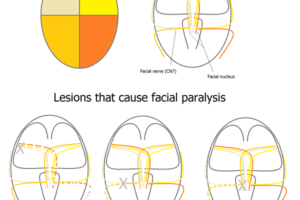These are topics that are often covered and tested in early medical neurobiology courses. They require an understanding of specific neuro-anatomical and systems concepts, while at the same time have clinical relevance.
Bell’s Palsy – a common disorder that has different manifestation depending on whether the lesion is central or peripheral. Requires knowledge of the organization of the Facial nerve (CN VII).
Lesions of the visual pathway – lesions at different levels of the visual pathway produce specific visual defects. Requires knowledge of the organization of CN II as well as the more central visual pathway.
Pupillary reflexes – sensory or motor lesions have different effects on pupillary reflexes. Requires knowledge of CN II, parasympathetic and motor pathways, and midbrain nuclei.
Hearing loss – distinguish between the two major classes of hearing loss, sensorineural and conductive.
Aphasia – distinguish between major types of aphasias, including Wernicke’s and Broca’s. Requires knowledge of auditory and speech pathways, as well as blood supply patterns.
Brown-Sequard syndrome – caused by a hemi-transection of the spinal cord, this produces classic and specific sensory and motor deficits. Requires knowledge of spinal cord anatomy and tract decussation locations.
Myesthenia gravis – an auto-immune disorder. Requires knowledge of synaptic neurotransmission and neuropharmacology.
Cortico-spinal tract – the major descending motor tract.
Spino-thalamic tract – the ascending pathway for pain and temperature information.
Dorsal column – medial lemniscus – the ascending pathway for touch and vibratory sensation.
Intracranial bleeds – among the most common neurological problems. Requires knowledge of brain coverings (dura, arachnoid) as well as brain vessels.

